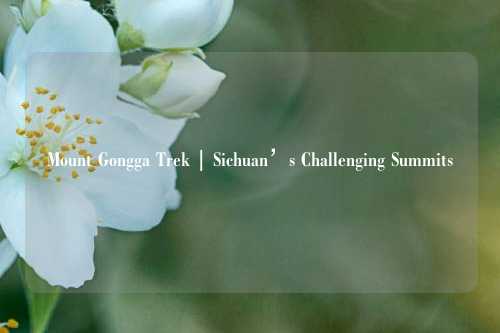Mount Gongga Trek | Sichuan’s Challenging Summits
A Towering Giant in Sichuan
Mount Gongga, also known as Minya Konka, stands as the highest peak in Sichuan Province and one of the most challenging summits in the world. Towering at 7,556 meters, this majestic mountain is often referred to as the "King of Sichuan Mountains." Its remote location, unpredictable weather, and technical terrain have made it a revered destination for experienced mountaineers and adventure seekers. Beyond its rugged peaks, the area surrounding Mount Gongga offers breathtaking landscapes, diverse ecosystems, and a deep cultural heritage waiting to be explored.
A Trek Through Pristine Valleys and Alpine Meadows
Trekking in the Mount Gongga region provides an opportunity to experience a landscape filled with untouched wilderness. The trails wind through lush forests, where rhododendron blossoms paint the landscape in vibrant colors during the spring and summer months. Alpine meadows stretch beneath towering peaks, offering trekkers moments of serenity amidst nature’s grandeur. Along the way, crystal-clear streams flow through the valleys, providing a source of life to the diverse flora and fauna inhabiting the region.

The Challenges of High-Altitude Trekking
Mount Gongga’s rugged terrain presents a formidable challenge for those seeking to conquer its peaks. The high altitude and dramatic weather changes demand careful preparation and acclimatization. Trekkers must navigate steep ascents, glacial paths, and unpredictable snowfall, making every step an endurance test. However, those who brave the journey are rewarded with panoramic views of some of the most awe-inspiring landscapes in western China.
Glaciers and Ice Fields of Mount Gongga
The mountain’s towering height gives rise to an extensive network of glaciers and ice fields. These frozen landscapes, some of the largest in Sichuan, create an otherworldly atmosphere that adds to the mountain’s allure. The Hailuogou Glacier, one of the most accessible in the region, offers a rare chance to witness the power of glacial movement up close. Visitors can see massive ice formations and crevasses that highlight the ever-changing nature of these frozen giants.
Rich Biodiversity in the Mountain’s Ecosystem
Mount Gongga is home to an incredible variety of plant and animal life, thriving across its different climatic zones. Dense forests at lower elevations provide shelter for wildlife, including rare species such as the snow leopard, red panda, and takin. The region’s varied altitudes create a patchwork of ecosystems, ranging from subtropical woodlands to alpine tundra. Birdwatchers and nature lovers will find endless opportunities to observe the rich biodiversity that flourishes in these remote highlands.
Tibetan Influence in the Remote Villages
The foothills of Mount Gongga are dotted with Tibetan villages, where ancient customs and traditions have been preserved for generations. The people of these highlands live in harmony with nature, practicing a way of life that reflects deep spiritual connections with the land. Monasteries and prayer flags adorn the landscape, adding a sense of tranquility to the journey. Visitors can experience warm hospitality, taste locally made yak butter tea, and witness traditional dances that celebrate the rich heritage of the region.
Monasteries and Sacred Sites
Several monasteries near Mount Gongga serve as important spiritual centers for Tibetan Buddhism. One of the most revered is Gongga Monastery, which sits at an altitude of over 3,700 meters. This centuries-old site has long been a place of meditation and religious study. The monks who reside here lead a peaceful life, surrounded by the stunning beauty of the mountains. Travelers who visit these sacred sites often find a sense of calm and reflection, adding a meaningful cultural aspect to their journey.
Best Seasons for Trekking
The optimal time for trekking in the Mount Gongga region is during the late spring and autumn months. From May to June, the valleys bloom with wildflowers, and the moderate temperatures make for comfortable trekking conditions. September to October offers clear skies and crisp air, allowing for uninterrupted views of the mountain’s towering peaks. Winter and early spring present harsher conditions, with heavy snowfall and extreme cold, making it a season best suited for only the most experienced climbers.
Popular Trekking Routes and Their Highlights
Several trekking routes allow visitors to experience the grandeur of Mount Gongga. One of the most popular is the Hailuogou Glacier route, which provides access to breathtaking ice formations and hot springs. For those seeking a longer and more immersive adventure, the circuit around Mount Gongga takes trekkers through diverse landscapes, from dense forests to high-altitude plateaus. The challenging ascent to the base camp rewards hikers with some of the most dramatic mountain scenery in China.
The Thrill of Summiting Mount Gongga
Climbing Mount Gongga itself is an expedition that few have completed. The mountain’s remote location, extreme altitude, and unpredictable conditions make it one of the most challenging peaks to conquer. Since the first recorded ascent in 1932, only a handful of climbers have successfully reached the summit. Those who attempt this climb must possess technical mountaineering skills and a deep understanding of high-altitude survival. The journey to the top is fraught with obstacles, but standing atop this massive peak is an achievement that few in the world can claim.
Natural Hot Springs for Relaxation
After days of trekking through rugged terrain, visitors can find relaxation in the region’s natural hot springs. Hailuogou Hot Springs, located near the glacier, provide a soothing retreat where weary travelers can soak in mineral-rich waters while surrounded by towering peaks. These geothermal pools offer a perfect balance to the physical demands of trekking, allowing visitors to unwind in the heart of nature.
Essential Tips for Trekkers
For those planning to explore Mount Gongga, preparation is key. Proper gear, including insulated clothing, sturdy hiking boots, and trekking poles, is essential for navigating the challenging terrain. Acclimatization is crucial, as the high altitude can pose health risks if ascended too quickly. Bringing sufficient food and water, as well as emergency supplies, ensures a safer trekking experience. Hiring experienced local guides can also enhance the journey, as they provide valuable insight into the landscape and cultural significance of the region.
The Enduring Legacy of Mount Gongga
Mount Gongga remains a place of awe and admiration, attracting adventurers, pilgrims, and nature lovers from across the world. Whether hiking through its lush valleys, experiencing the warmth of Tibetan hospitality, or gazing upon its snow-covered summits, visitors are left with an unforgettable impression of this majestic mountain. It stands as a symbol of both challenge and beauty, inviting those who seek an extraordinary journey into one of China’s most remote and breathtaking landscapes.
















